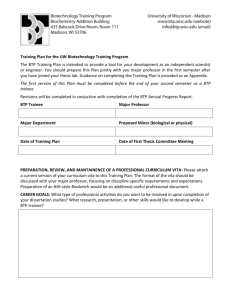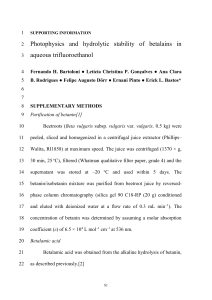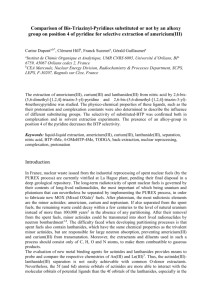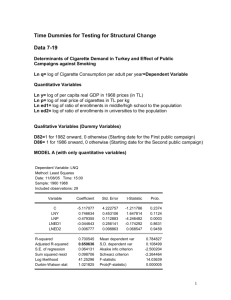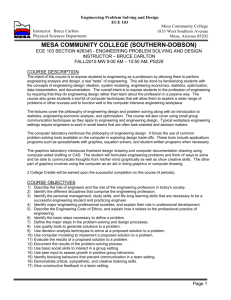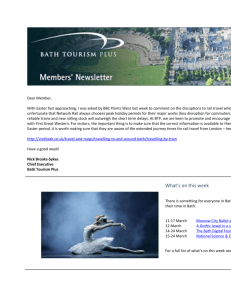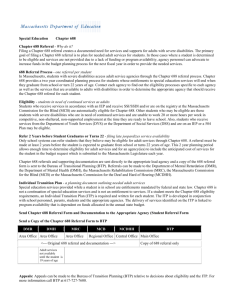Carrier Protocol Bindings
advertisement
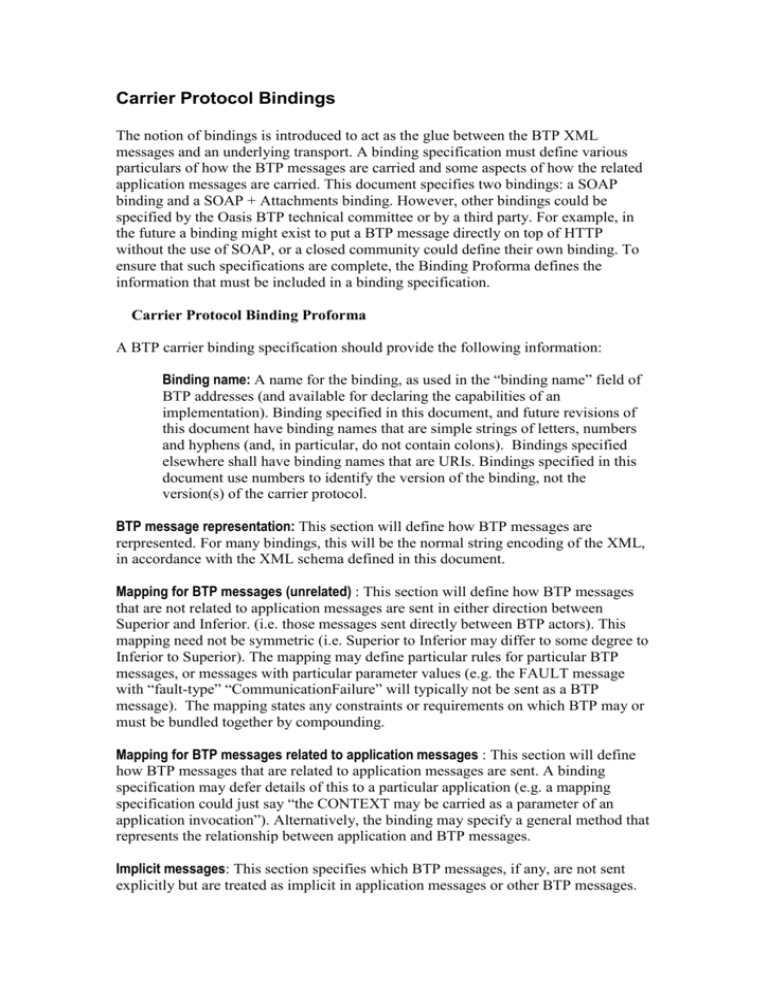
Carrier Protocol Bindings The notion of bindings is introduced to act as the glue between the BTP XML messages and an underlying transport. A binding specification must define various particulars of how the BTP messages are carried and some aspects of how the related application messages are carried. This document specifies two bindings: a SOAP binding and a SOAP + Attachments binding. However, other bindings could be specified by the Oasis BTP technical committee or by a third party. For example, in the future a binding might exist to put a BTP message directly on top of HTTP without the use of SOAP, or a closed community could define their own binding. To ensure that such specifications are complete, the Binding Proforma defines the information that must be included in a binding specification. Carrier Protocol Binding Proforma A BTP carrier binding specification should provide the following information: Binding name: A name for the binding, as used in the “binding name” field of BTP addresses (and available for declaring the capabilities of an implementation). Binding specified in this document, and future revisions of this document have binding names that are simple strings of letters, numbers and hyphens (and, in particular, do not contain colons). Bindings specified elsewhere shall have binding names that are URIs. Bindings specified in this document use numbers to identify the version of the binding, not the version(s) of the carrier protocol. BTP message representation: This section will define how BTP messages are rerpresented. For many bindings, this will be the normal string encoding of the XML, in accordance with the XML schema defined in this document. Mapping for BTP messages (unrelated) : This section will define how BTP messages that are not related to application messages are sent in either direction between Superior and Inferior. (i.e. those messages sent directly between BTP actors). This mapping need not be symmetric (i.e. Superior to Inferior may differ to some degree to Inferior to Superior). The mapping may define particular rules for particular BTP messages, or messages with particular parameter values (e.g. the FAULT message with “fault-type” “CommunicationFailure” will typically not be sent as a BTP message). The mapping states any constraints or requirements on which BTP may or must be bundled together by compounding. Mapping for BTP messages related to application messages : This section will define how BTP messages that are related to application messages are sent. A binding specification may defer details of this to a particular application (e.g. a mapping specification could just say “the CONTEXT may be carried as a parameter of an application invocation”). Alternatively, the binding may specify a general method that represents the relationship between application and BTP messages. Implicit messages: This section specifies which BTP messages, if any, are not sent explicitly but are treated as implicit in application messages or other BTP messages. This may depend on particular parameter values of the BTP messages or the application messages. Faults: The relationship between the fault and exception reporting mechanisms of the carrier protocol and of BTP shall be defined. This may include definition of which carrier protocol exceptions are equivalent to a FAULT/communication-failure message. Relationship to other bindings: Any relationship to other bindings is defined in this section. If BTP addresses with different bindings are be considered to match (for purposes of identifying the peer Superior/Inferior and redirection), this should be specified here. Limitations on BTP use: Any limitations on the full range of BTP functionality that are imposed by use of this binding should be listed. This would include limitations on which messages can be sent, which event sequences are supported and restrictions on parameter values. Such limitations may reduce the usefulness of an implementation, but may be appropriate in certain environments. Other: Other features of the binding, especially any that will potentially affect interoperation should be specified here. This may include restrictions or requirements on the use or support of optional carrier parameters or mechanisms> SOAP Binding This binding describes how BTP messages will be carried using SOAP as in the SOAP 1.1 specification. Binding name: soap-http-1 BTP message representation: The string representation of the XML, as specified in the XML schema defined in this document shall be used. BTP messages conform to the rules of the Section 5 (of the SOAP 1.1 specification) SOAP Encoding as specified by the URI: "http://schemas.xmlsoap.org/soap/encoding/". Mapping for BTP messages (unrelated): If no application message is being sent at the same time, BTP messages shall be contained in a btp:messages element which shall be an immediate child element of the SOAP-Body. There shall be precisely one btp:messages element. Any number of BTP messages with the same binding address in their target address may be carried in the same btp:messages element. If an application message is being sent at the same time, the mapping for related messages shall be used, as if the BTP messages were related to the application message. (There is no ambiguity in whether the BTP messages are related, because only CONTEXT can be related to an application message.) Mapping for BTP messages related to application messages: All BTP messages sent with an application message, whether related to the application message or not, shall be sent in a single btp:messages element in the SOAP:Header. There shall be precisely one btp:messages element in the SOAP:Header. Implicit messages: A SOAP fault, or other communication failure received in response to a SOAP request that had a CONTEXT in the SOAP:Header shall be treated as if a CONTEXT-REPLY/repudiated had been received. See also the discussion under “other” about the SOAP mustUnderstand attribute. Faults: A SOAP fault or other communication failure shall be treated as FAULT/communication-failure. Relationship to other bindings: A BTP address for Superior or Inferior that has the binding string “soap-http-1” is considered to match one that has the binding string “soap-attachments-http-1” if the binding address and additional information fields match. Limitations on BTP use: None Other: The SOAP BTP binding does not make use of SOAPAction HTTP header or actor attribute. The SOAPAction HTTP header is left to be application specific when there are application messages in the SOAP:Body, as an already existing web service that is being upgraded to use BTP might have already made use of SOAPAction. The SOAPAction HTTP header shall be omitted when the SOAP message carries only BTP messages in the SOAP:Body. The SOAP mustUnderstand attribute, when used on the btp:messages containing a the BTP CONTEXT, ensures that the server (as a whole) determines whether any enrolments are necessary and reply with CONTEXT-REPLY as appropriate. If mustUnderstand if false, a server can ignore the CONTEXT (if BTP is not supported there). It is an implementation or configuration option whether a CONTEXTREPLY/ok is assumed to be implicit in the HTTP response in such a case. (If no CONTEXT-REPLY/ok is assumed, it will be impossible for the business transaction to confirm) . Note – some SOAP implementations may not support the mustUnderstand attribute sufficiently to enforce these requirements. If using such an implementation on the service side, it may be necessary to assume an CONTEXT-REPLY/ok. Example scenario using SOAP binding The example below shows an application request with CONTEXT message sent from client.example.com (which includes the Superior) to services.example.com (Service). <soap:Envelope xmlns:soap="http://schemas.xmlsoap.org/soap/envelope/" soapenv:encodingStyle="http://schemas.xmlsoap.org/soap/encoding/"> <soap:Header> <btp:messages xmlns:btp="urn:oasis:names:tc:BTP:xml"> <btp:context superior-type="atom"> <btp:superior-address> <btp:binding>soap-http-1</btp:binding> <btp:bindingaddress>http://client.example.com/soaphandler</btp:bindingaddress> <btp:additionalinformation>btpengine</btp:additional-information> </btp:superior-address> <btp:superior-identifier>1001</btp:superior-identifier> <btp:qualifiers> <btpq:transaction-timelimit xmlns:btpq=”urn:oasis:names:tc:BTP:qualifiers”>1800</btpq:trans action-timelimit> </btp:qualifiers> </btp:context> </btp:messages> </soap:Header> <soap:Body> <ns1:orderGoods xmlns:ns1="http://example.com/2001/Services/xyzgoods"> <custID>ABC8329045</custID> <itemID>224352</itemID> <quantity>5</quantity> </ns1:orderGoods> </soap:Body> </soap:Envelope> The example below shows CONTEXT-REPLY and a related (and therefore contained) ENROL message sent from services.example.com to client.example.com, in reply to the previous message. There is no application response, so the BTP messages are in the SOAP:Body. <soap:Envelope xmlns:soap="http://schemas.xmlsoap.org/soap/envelope/" soapenv:encodingStyle="http://schemas.xmlsoap.org/soap/encoding/ "> <soap:Header> </soap:Header> <soap:Body> <btp:messages xmlns:btp="urn:oasis:names:tc:BTP:xml"> <btp:context-reply> <btp:superior-address> <btp:binding>soap-http-1</btp:binding> <btp:binding-address> http://client.example.com/soaphandler </btp:binding-address> <btp:additional-information> btpengine </btp:additional-information> </btp:superior-address> <btp:superior-identifier>1001</btp:superior-identifier> <completion-status>related</completion-status> <btp:enrol reply-requested="false"> <btp:target-additional-information> btpengine </btp:target-additional-information> <btp:superior-identifier> 1001 </btp:superior-identifier> <btp:inferior-address> <btp:binding>soap-http-1</btp:binding> <btp:binding-address> http://services.example.com/soaphandler </btp:binding-address> </btp:inferior-address> <btp:inferior-identifier> AAAB </btp:inferior-identifier> </btp:enrol> </btp:context-reply> </btp:messages> </soap:Body> </soap:Envelope> SOAP + Attachments Binding This binding describes how BTP messages will be carried using SOAP as in the SOAP Messages with Attachments specification. It is a superset of the Basic SOAP binding, soap-http-1. The two bindings only differ when application messages are sent Binding name: soap-attachments-http-1 BTP message representation: As for soap-http-1 Mapping for BTP messages (unrelated): As for “soap-http-1” , except the SOAP:Envelope containing the SOAP-Body containing the BTP messages shall be in a MIME body part, as specified in SOAP Messages with Attachments specification. If an application message is being sent at the same time, the mapping for related messages for this binding shall be used, as if the BTP messages were related to the application message(s). Mapping for BTP messages related to application messages: MIME packaging shall be used. One of the MIME multipart/related parts shall contain a SOAP:Envelope, whose SOAP:Headers element shall contain precisely one btp:messages element, containing any BTP messages. Any BTP CONTEXT in the btp:messages is considered to be related to the application message(s) in the SOAP:Body, and to also any of the MIME parts referenced from the SOAP:Body (using the “href” attribute). Implicit messages: As for soap-http-1. Faults: As for soap-http-1. Relationship to other bindings: A BTP address for Superior or Inferior that has the binding string “soap-http-1” is considered to match one that has the binding string “soap-attachements-http-1” if the binding address and additional information fields match. Limitations on BTP use: None Other: As for soap-http-1 Example using SOAP + Attachments binding MIME-Version: 1.0 Content-Type: Multipart/Related; boundary=MIME_boundary; type=text/xml; start="someID" --MIME_boundary Content-Type: text/xml; charset=UTF-8 Content-ID: someID <?xml version='1.0' ?> <soap:Envelope xmlns:soap="http://schemas.xmlsoap.org/soap/envelope/" soapenv:encodingStyle="http://schemas.xmlsoap.org/soap/encoding/ "> <soap:Header> <btp:messages xmlns:btp="urn:oasis:names:tc:BTP:xml"> <btp:context superior-type="atom"> <btp:superior-address> <btp:binding>soap-http-1</btp:binding> <btp:binding-address> http://client.example.com/soaphandler </btp:binding-address> </btp:superior-address> <btp:superior-identifier>1001</btp:superioridentifier> </btp:context> </btp:messages> </soap:Header> <soap:Body> <orderGoods href="cid:anotherID"/> </soap:Body> </soap:Envelope> --MIME_boundary Content-Type: text/xml Content-ID: anotherID <ns1:orderGoods xmlns:ns1="http://example.com/2001/Services/xyzgoods"> <custID>ABC8329045</custID> <itemID>224352</itemID> <quantity>5</quantity> </ns1:orderGoods> --MIME_boundary--
